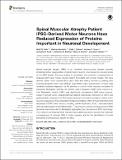Spinal muscular atrophy patient iPSC-derived motor neurons have reduced expression of proteins important in neuronal development
View/
Date
11/01/2016Author
Funder
Grant ID
094476/Z/10/Z
Keywords
Metadata
Show full item recordAbstract
Spinal muscular atrophy (SMA) is an inherited neuromuscular disease primarily characterized by degeneration of spinal motor neurons, and caused by reduced levels of the SMN protein. Previous studies to understand the proteomic consequences of reduced SMN have mostly utilized patient fibroblasts and animal models. We have derived human motor neurons from type I SMA and healthy controls by creating their induced pluripotent stem cells (iPSCs). Quantitative mass spectrometry of these cells revealed increased expression of 63 proteins in control motor neurons compared to respective fibroblasts, whereas 30 proteins were increased in SMA motor neurons versus their fibroblasts. Notably, UBA1 was significantly decreased in SMA motor neurons, supporting evidence for ubiquitin pathway defects. Subcellular distribution of UBA1 was predominantly cytoplasmic in SMA motor neurons in contrast to nuclear in control motor neurons; suggestive of neurodevelopmental abnormalities. Many of the proteins that were decreased in SMA motor neurons, including beta III-tubulin and UCHL1, were associated with neurodevelopment and differentiation. These neuron-specific consequences of SMN depletion were not evident in fibroblasts, highlighting the importance of iPSC technology. The proteomic profiles identified here provide a useful resource to explore the molecular consequences of reduced SMN in motor neurons, and for the identification of novel biomarker and therapeutic targets for SMA.
Citation
Fuller , H , Mandefro , B , Shirran , S L , Gross , A , Kaus , A , Botting , C H , Morris , G & Sareen , D 2016 , ' Spinal muscular atrophy patient iPSC-derived motor neurons have reduced expression of proteins important in neuronal development ' , Frontiers in Cellular Neuroscience , vol. 9 , 506 . https://doi.org/10.3389/fncel.2015.00506
Publication
Frontiers in Cellular Neuroscience
Status
Peer reviewed
ISSN
1662-5102Type
Journal article
Description
This work was supported by The RJAH Institute of Orthopaedics, UK (H.F.), The SMA Trust, UK (H.F.), Cedars-Sinai Institutional startup funds (D.S), California Institute for Regenerative Medicine Grant RT-02040 (D.S.), National Center for Advancing Translational Sciences (NCATS), Grant UL1TR000124 (D.S.), and the Wellcome Trust [grant number 094476/Z/10/Z] which funded the purchase of the TripleTOF 5600 mass spectrometer at the BSRC Mass Spectrometry and Proteomics Facility, University of St Andrews (S.S. and C.B.). D.S. is also supported by funds from National Institute of Health (NINDS) grant U54NS091046. The funders had no role in study design, data collection and analysis, decision to publish, or preparation of the manuscript.Collections
Items in the St Andrews Research Repository are protected by copyright, with all rights reserved, unless otherwise indicated.

